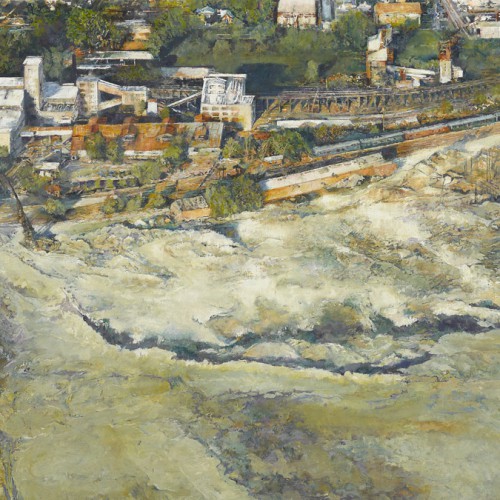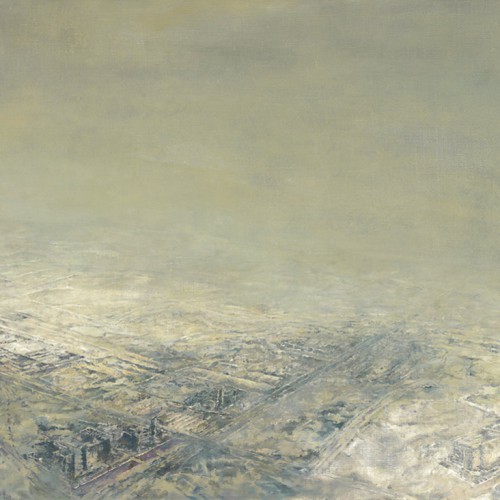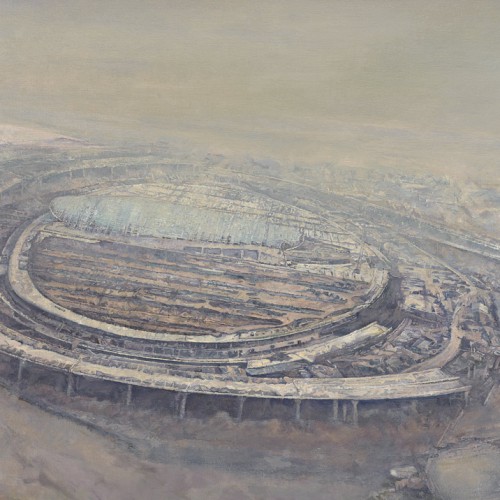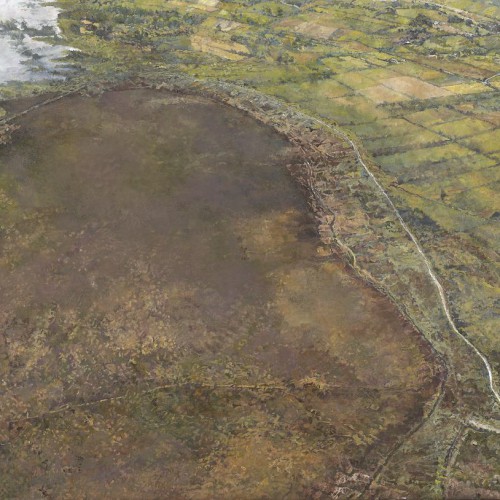Thérèse Oulton’s catalogue essay for Territory at Marlborough Fine Art, London, 2010.
- Untitled no.1, 2007
- Untitled no. 6, 2007
- Untitled no. 14, 2008
- Untitled no. 13, 2009
During the long period inching my way into these new paintings, visitors to the studio brought up various questions, reflections, comments here recorded as best I can – fragments, some jotted down at the time some not, so decidedly unreliable. Considering the lack of any transitional works marking the route from the ‘old self’, my nerves about their showing were nearly always redundant. More visitors seemed to claim there was no change, that they were still recognisably, coherently mine. Was I to take this as a heartening proof that identity languishes somewhere beyond ‘styles of radical will’, or despondent that I hadn’t achieved the desired and revolutionary shift into the being another person, another painter. In its title alone the exhibition prior to this looks retrospectively prescient of a becoming strategy. Lines of Flight might have aspired to flee away, flight from as well of course to their own concerns.
So the high perspective of Territory could possibly be from a direction towards the more earthbound from an even-further-away, coming to their height from an outer space. Of course all flights leave their ‘lines’. And given perspectival height backwards into even earlier selves, older structural passions, perhaps this body of paintings is less aberrant.
Visitor B who, (along with many others) always thought of my paintings as in some senses ‘geological’. No: I’ve been a geographer at heart. Surfaces, not underneaths- though I do see more mines and quarries in the imagery than is warranted. Any surface (a truism for any painter) as material remains of past event, it’s that that is a common, continual engagement; here, the surface of the earth, which I cannot not see as scarred, stigmata-like; this is the evidence of plundering, scrapings, gouges, constructions, not only human. The human eye looking, glancing most likely, is trace enough of human presence (though of course in its many absences.) And there are no ‘underneaths’, no insides. The ‘into’ reaches yet another surface anyway.
I was reading about the birth of aerial archaeology. An RAF flyer returning from a reconnaissance flight from France noticed an unexplainable circle somewhere over Wiltshire. The light was a low, raking evening light. There was a light dusting of snow. Both conditions are ideal for the making visible of phenomena long since invisible from mere ground level. It was the vestiges of a wood Henge. From that, aerial photography was henceforth literally one of the insights into the past, used to read the deeper, older surfaces as it were; medieval villages and strip farming practices perfectly drawn co-existing with the harvesting patterns made by gigantic agri-businesses, ancient watercourses again snaking their ghostly way through long since dried-up river valleys – all manner of histories again part of the surface ciphers. Palimpsests.
There are antinomies aplenty through not just the geological versus the geographical: brute land-usage and the picturesque, industrial and post-industrial and simply, land versus the sea. My friend V who needed maps for the once-secret Sino-Russian border now declassified, had me idly looking at maritime charts, ocean charts for every conceivable purpose in Stamfords, Long Acre, the intimate divisions of an entity so amorphous as the sea yet that too territorialized. It feels claustrophobic, no space left for the mind to imagine earth untrammelled and even the oceans are too, and sadly, industrial sites. The slightly ludicrous aspect as well, humans making geometry out of the ocean. Painting ‘sea’ was an entirely perplexing task: that crinkled surface. In fact whilst painting different entities I thought more ‘smooth or rumpled, striated or gouged’ as opposed to water, mountain, desert – the words I mean. Up close and walking, mountains regain their old Romantic mystery and awesomeness, their ‘sublime’. Flying high above a range, they are crumpled bits of surface, disappointingly exposed for what they are. ‘Is that all there is’ – until of course they transmogrify again and sight of them become yet again mysterious, the endless innovation of matter, grand in their endless foldings, shadow-valleys, the visible in all its uncanniness.
…there was a purplish stain upon the bland surface of the sea as if something had boiled and bled, invisibly, beneath. This intrusion into a scene calculated to stir the most sublime reflections and lead to the most comfortable conclusions stayed their pacing. It was difficult blandly to overlook them; to abolish their significance in the landscape; to continue, as one walked by the sea…1
J: From your verbal description, I was expecting something more literal. These are quite, quite strange. Because of their minutest detail one would expect an affirmation in the mimetic order but these have the effect of clouding what should clarify. It’s very disconcerting. A sort of disturbance comes to dominate there.
Me: I think that too. The extreme attention to detail would seem to imply the proximal though landscape, because it is ‘the beyond’ exacerbates remoteness, the virtual, glorifies distance.
J again: Paintings have this gift for reserving a part of themselves for negating what they affirm in the mimetic order.
M: Is their small scale a protest against all the gigantisms around us in the art world?
Me: Not really. Their modest scale coupled with the big space depicted, the contrast I thought made for whatever specifics they have – and avoiding any sense of the confidence that large-scale works emit. That last is quite important come to think of it.
VERTIGO.
It’s curious that a person who suffers from vertigo should paint landscapes from a high vantage point. To climb to the top of Mount Sarakura overlooking the city of Kitakyushu in Japan’s south-eastern most island, I took a cable car. The final ascent after the station was about an hour on foot. That was no problem but the cable car was. As it emerged suddenly from the dark of the forested slopes onto bare mountainside and bright light, the loss of orientation was so strong that I fainted. A kind Korean woman, the only other person on the train besides myself came to my rescue and accompanied me for the remainder of the ascent. At the top she pointed out the directions, of Vladivostok and Korea while I took pictures not then with an intent to re-make the images as paintings – far from my mind.
The same experience, including the fainting, repeated itself whilst ascending – this time via a tiny glass lift – one of the towers of Gaudi’s La Sagrada Familia in Barcelona. Again it was the shift in light, the dark to light, the cold terror of the abyss opening at one’s feet. This time I got no pictures at all because I couldn’t even get out of the glass box. The lift man who had obviously seen other vertigo attacks in his time gave me my money back.
The city of Kitakyushu is famous for its sushi and one could imagine a perfectly pristine coast, fishing villages, turquoise sea that is now heavily industrialised, a row of orange and white striped power plants the length of the coast as far as one could see. From my mountain top a thick layer of greenish pollution stretching left and right was distinct from the clear blue above. The city itself though looking mainly post-war development seemed to follow the graceful contours of the coast squeezed in between it and the mountains behind. It had a natural unnaturalness about it, something alienating but stunning. Whatever it was, it began this series, Territory – that and the vertigo.
Visitor L and I were having a discussion on the difficulty of getting the right image. Mountains belong to the Romantics (who might have wanted to go still higher had the chance been offered) and there is not always a mountain or a tall building in the right place. Aerial photos are actually too high for my purposes as they flatten into pattern. They are too map-like thereby lose perspective and hence the human in the sense of a ground to put your feet on. I was looking for a compendium of evidence as to the human. There was some trial and some error in this discovery. Aeroplane take-off height is ideal but then that would limit me to airports. L suggested “Why don’t you use Google Earth as source material since it gives access to an infinity of images.” Yes; but it’s the wrong sort of infinity.
A TALE OF TWO TOWERS.
Tower blocks, especially of the newer, gigantic variety are an obvious vantage point from which to get images (through they are normally limited to cityscapes) and one such and privileged occasion arose during a visit to Beijing. The construction of the Rem Koolhaus CCTV building was at a stage just before its black shiny cladding; the construction site was the size of a small town; the chief engineer R’s invitation our chance to see it and the awesome sight of downtown Beijing from the height of the adjacent building. R oversaw the site from a lofty, god-like perspective from its twenty-forth floor. Those images never did get used, painted. Perhaps the building is too much of a landmark and anonymity is my landmark.
Another city, another landmark building, the Trellick Tower orientating me whilst taking short cuts through the council estates of West London proved a tale of lack of privileged access in our security conscious world. Gone are the days when you could simply ask the concierge politely for permission to take pictures on the roof ‘because you were an artist’. No-one buys that anymore and regards you with suspicion. I did try. If you were a film crew and had the required large sums available, it was possible. So with a mixture of dismay at the paranoia of contemporary society and relief that I wouldn’t have to paint all those buildings I abandoned tower blocks’ vantage points for source material. In both cases though, I was particularly taken with the grimy beauty of raised motorways snaking their way, artery-like through an otherwise vertical scene.
The Trellick Tower again. The top-most glass box of its independent slender ‘side-stack’, apocryphal myth of not originally had the sinister surveillance purpose for the control of expected civil unrest. Altitude, grand expanse will always have the association of control. Height is an intrinsic part of the practical side of espionage and policing, an essential component of military planning. It was after all an airman the ‘inventor’ of aerial archaeology, and his reconnaissance mission wasn’t for peaceful purposes. Perhaps the small scale of the paintings was in some sense to militate against the meaning of power inextricably linked to viewpoint. Then again, a small spy-hole is no less intrusive and controlling.
The landscape in which I’m writing this, this dry side of the island is a miracle of aubergine-black lava flowing in a vast vertically striated field from the volcano into the pacific. Shockingly, the brand new highway cuts laterally across its ploughed-looking cragginess, a seriously libidinal pull for me to paint. But can I find a way of getting an image of it? No, not even a ready-made as it falls into none of the given categories that make it photograph-worthy.
Then there is the problem of the recognisable. Having climbed (yet another tower, spire in fact) Cologne Cathedral I lingered un-decided for a long time over the images taken. Whether to paint the once flattened city, the Rhine beyond, ended reluctantly with a rejection. You could see exactly what it was and from what building it was photographed, an already-known. Aerial photography, a thing of intrinsic beauty used to be in essence the unfamiliar view. I think perhaps that is no longer the case and it is already become over-familiar. My latest idea to have access to a ready-made image without that image being fixed and already a ‘view’ – plus giving one choice as to angle, tilt and so on is off the television. In fact the last painting in the show is such an experiment. May it not imply too much TV watching for the future.
Another of my visitors remarked how far away were my landscapes from a landscape tradition of attachment to place, so often in the past that of a childhood geography. Why wasn’t I giving the paintings locations, place names as titles even. Landscapes are peopled by our presence, our memory searches for a sentimental landscape said visitor B. For it to be not that.To disengage from that very thing; to be a sense of our remoteness from objects tingeing the entire image of nature for those living outwardly separated from what might once have been close to their heart. Fewer and fewer people do actually come from, stay on, one small patch of the earth anymore. They may be the lucky ones; the others may be if they lose a village and gain the whole world. But mostly it’s an alienated relation to place and these (said another visitor) are paintings of alienation. Attachment or not, the earth itself remains indifferent. The familiar deludes one into saying otherwise. Lack of the familiar, of the beloved known, and the land takes on a shifting quality, one that accords with the surface of a life. My own early years were on RAF campus classically (then) a childhood of displacement but there are two paintings here of the nearest I came during adolescence to belonging anywhere. No-one can see any difference in their indifference, myself included.
There are collections, books of aerial photography aplenty; abstracted patterns, picturesque, sublime, utilitarian, conscience-laden reminders of the extent of our intervention, sinister surveillance records – every aspect of aerial photography there. The by-now not so novel view must fascinate, our eyes at least take wing.
The colour blue, the tinge nearest to air, to atmosphere, becomes subject matter, the medium through which distance itself becomes subject matter. As well as aetherialising solid mountain ranges, transforming into barely-thereness busy metropoli, it makes for distance too, makes nature remote from touch. Atmosphere divides. Atmosphere unites – and not any longer only in the sense of alluring far-distances. We can look down at earth and it’s the blue of far distance that makes one forlornly body-less, left only with sight, no comfortable feet on solid ground, no reassuring touch. There was a moment with my camera when I fell in love, discovered briefly ‘the zoom’. You could get up close. The blue of the air could become subject matter in and for itself; land, ether yet be close enough for a sense almost of touch. To still swim in the blue far-away but close, both I thought. But no. Remote, separated, an insuperable gap between painter/viewer and the world, the practical unattainability of things seen.
Speaking of cameras: one visitor as we were talking about ‘shadow marks’, meaning both in the paintings and as markings on the earth surface, said photography was apt as index, not understood only as the material remains of a trace, the vestige of a contact. Yes, in fact a blow, a material impact. Implications of damage might add a dimension of symptom, the trace of such on the body of the earth.
Photography (and film) references were certainly not foreign to the paintings previous to these though their relationship to them obviously very different – and oblique enough for few to notice. Since from height alone one cannot hover in space to paint, so yes, photography is a necessary preliminary beginning to a painting. But it is also part of the seen in the paintings, the experience of them. Even the differing types of photographic imagery, the digital as opposed to the analogue, the various cameras’ behaviour, acknowledged. As in, no doubt the experience in looking at all painting now; painting as index of photography no less than photography index of painting.
Of particular importance to register to me is photography’s failure to delete accretions of detail, that chaos of detail anathema to paintings’s grand hierarchies, the exchange of the much for the little. It is assumed that it is ‘ordered’ in fact only because it is presented as art. Twenty-first century memory is suffering losses as technical memory substitutes. Photography tears subjective memory to shreds. There is nothing like a photograph to obliterate a real memory overlaying it with its own. Somewhere I read, noted, “Photography, a tool of amnesia.” A rememberer used to be one who paused, metaphorically or not, stood still to recall often in a familiar landscape. Travelling in aeroplanes, space seems to be especially unobserved, often my porthole the only one open, me staring out from the plane of sleeping, reading, screen-watching passengers.
I was glad visitor J brought the association up, as I was tempted and can now resist calling only one of the paintings by a title, ‘Babel’. Evidently then I’m not alone in seeing in that interplanetary structure a metamorphosis of the Breughel. Not only is it a razed-to-the-ground version of the termite-mound building of the Breughel but the crystalline azure blue-green atmosphere of the original is become a magenta-hued smog.
Land, the way it looks, with or without human intervention, it looks how it looks; there, matter constantly shifting about unfit to be the landscape of political control imagined as our right and subject enough for an attempted redemption against catastrophe wrought on it.
This appealed to the walker in me, the earthbound lover, feet, touch on the ground:
Was a high high wall there that tried to stop me
A sign was painted said! Private Property
But on the other side, it didn’t say nothin’
That side was meant for you and me.2
Me and my walking partner of many years have often seen this sign, been turned away by such. In spite of all possible aids and lots of experience we invariably get lost and could do with the perspective of elevation sometimes to extricate ourselves, literally to see the lie of the land – and the way home. Walking time is relentless linear time, a strict chronology, time as succession, implacable cause and effect. Not so the high viewpoint, not the strict sequence of before and after. That sweeping look does not need the careful coordination of the the foot and eye of the walker but is liberated from the orderly sequence of linked events. It triumphs over the huge distances, the barriers to private property, the hazardous-to-cross, the difficult to climb. But it in its turn becomes proprietal, the eye the disembodied owner of all it surveys.
T.O.



